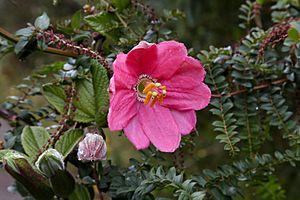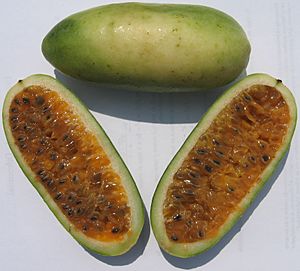Banana passionfruit facts for kids
Quick facts for kids Banana passionfruit |
|
|---|---|
 |
|
| Passiflora mixta | |
| Scientific classification |
|
| Kingdom: | Plantae |
| Clade: | Tracheophytes |
| Clade: | Angiosperms |
| Clade: | Eudicots |
| Clade: | Rosids |
| Order: | Malpighiales |
| Family: | Passifloraceae |
| Genus: | Passiflora |
| Supersectio: | Passiflora supersect. Tacsonia (Juss.) Feuillet & J.M.MacDougal (2003) |
| Type species | |
| Passiflora mixta Lam.
|
|
| Species | |
|
See text |
|
| Synonyms | |
|
|
The Banana passionfruit (Passiflora supersect. Tacsonia) is also known as taxo or curuba. It is a group of about 64 different types of Passiflora plants. These plants are mostly found in South America. They often grow in high cloud forests, which are misty and wet areas. Their flowers have a special tube-like shape called a cylindrical hypanthium.

What are Invasive Species?
Some types of banana passionfruit, like P. tarminiana and P. tripartita, grow very well in places like New Zealand. However, they are considered invasive species. This means they grow so fast and spread so much that they can take over and harm the native plants. They can cover up forest edges and new trees, stopping them from growing. Because of this, it is against the law to sell, grow, or give away these specific plants in New Zealand.
These banana passionfruit vines are also causing problems in Hawaii and Kauai. They are covering more than 520 square kilometers (200 square miles) of native forests there! Their seeds are spread by wild pigs, birds, and even people. You can also find these vines growing in the highlands of New Guinea and Tasmania.
Images for kids
See also
 In Spanish: Curuba para niños
In Spanish: Curuba para niños







